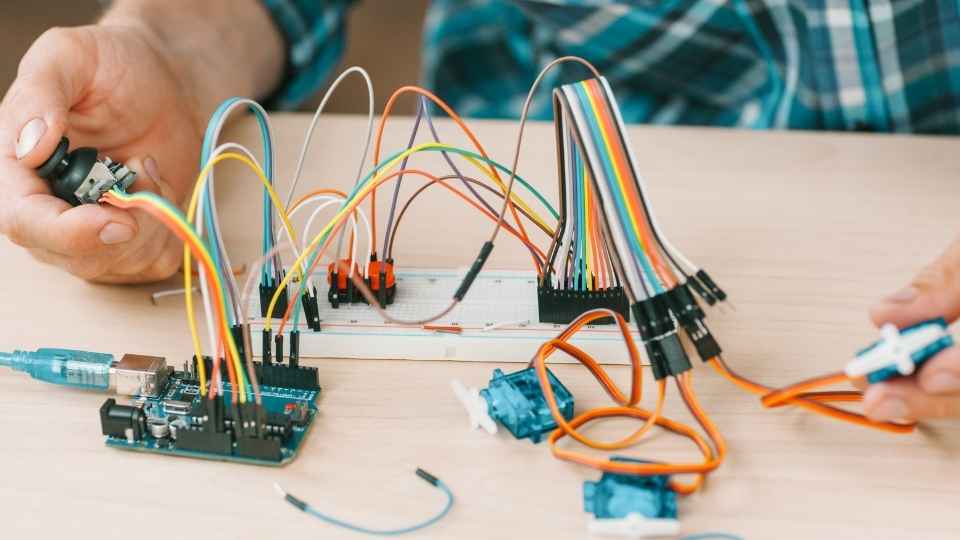
Power consumption is a paramount concern in the realm of microcontrollers. How do these small yet mighty devices maintain efficiency?
This article delves into the intricate world of low power considerations, energy efficiency, sleep mode activation, voltage regulation, power sources, and power management techniques.
By optimizing power consumption through meticulous strategies and leveraging the latest advancements in technology, microcontrollers strive to strike a delicate balance between performance and energy conservation.
Join us on this enlightening journey as we unravel the secrets behind their efficient operation.
Key Takeaways
- Power management techniques such as adjusting voltage and frequency based on workload significantly reduce power consumption without sacrificing performance.
- Microcontrollers are designed for tasks with minimal power consumption, and optimizing clock frequency and voltage levels reduces power wastage.
- Sleep mode is an effective way to reduce energy usage when microcontrollers are not active, by shutting off unnecessary peripherals and reducing the clock frequency.
- Voltage regulation mechanisms, such as linear regulators and switching regulators, ensure stable and reliable performance by maintaining a constant and precise voltage supply.
Low Power Considerations
When designing microcontrollers, engineers must carefully consider low power considerations in order to ensure efficient operation and maximize battery life. One of the key factors to consider is power management techniques. These techniques involve dynamically adjusting the voltage and frequency of the microcontroller based on its workload. By reducing the voltage and frequency when the workload is low, power consumption can be significantly reduced without sacrificing performance.
Another consideration is optimizing code execution. This involves minimizing unnecessary instructions, using efficient algorithms, and utilizing sleep modes whenever possible. Additionally, hardware features such as clock gating and power gating can be employed to selectively disable unused components or subsystems, further reducing power consumption.
Energy Efficiency
To optimize the operation of microcontrollers, a key focus is on enhancing energy efficiency. Microcontrollers are designed to perform tasks with minimal power consumption, making them ideal for battery-powered devices and applications where energy conservation is critical. Achieving high energy efficiency involves various techniques that minimize power wastage without compromising performance.

One approach to enhance energy efficiency in microcontrollers is through optimizing clock frequency and voltage levels. By dynamically adjusting these parameters based on workload requirements, power consumption can be significantly reduced.
Additionally, incorporating low-power modes such as sleep or idle states helps conserve energy during periods of inactivity.
Furthermore, utilizing advanced power management techniques like dynamic voltage scaling (DVS) and adaptive voltage scaling (AVS) allows microcontrollers to match their supply voltages with the required performance levels, resulting in further power savings.
Overall, the pursuit of energy efficiency in microcontroller design ensures longer battery life and reduced overall system costs while providing freedom for developers to create innovative solutions for a wide range of applications.
Sleep Mode
Sleep mode, a low-power state in microcontrollers, allows for reduced energy usage while the device is not actively performing tasks. When a microcontroller enters sleep mode, it suspends or slows down its operations to conserve power. This is achieved by shutting off unnecessary peripherals and reducing the clock frequency. While in sleep mode, the microcontroller remains responsive to external events that can wake it up from its slumber. By utilizing sleep mode effectively, developers can significantly extend battery life and improve energy efficiency in their devices.
To enter sleep mode, developers must configure the microcontroller's power management settings appropriately. This involves selecting the desired level of power reduction and defining which peripherals should be disabled or put into lower-power states during this period. Additionally, developers need to consider how long the device will remain in sleep mode before waking up and resuming normal operation.
Voltage Regulation
Voltage regulation is a critical aspect of ensuring stable and reliable performance in microcontrollers. Microcontrollers require a constant and precise voltage supply to function properly. Fluctuations in voltage can lead to erratic behavior and even system failures. To address this, microcontrollers employ voltage regulation mechanisms that maintain a steady voltage level despite variations in the power source or load conditions.

One common method used for voltage regulation is the use of linear regulators. These regulators provide a stable output voltage by adjusting their internal resistance based on the input voltage fluctuations. However, linear regulators are not very efficient as they dissipate excess energy as heat.
To overcome this limitation, modern microcontrollers often utilize switching regulators. These regulators convert the input voltage to a higher frequency AC signal and then rectify it back to DC at the desired output level. Switching regulators offer higher efficiency by minimizing energy losses during conversion.
Power Sources
One essential aspect to consider when designing microcontrollers is the reliability and stability of the power sources they rely on. Power sources play a crucial role in ensuring that microcontrollers function efficiently and reliably. Microcontrollers typically require a stable and regulated power supply to operate optimally, as fluctuations or interruptions can result in data loss or system failure.
To address this concern, designers often employ various techniques to ensure dependable power delivery. This includes utilizing voltage regulators, which maintain a constant output voltage despite input fluctuations. Additionally, designers may incorporate backup power solutions such as batteries or capacitors to provide temporary power during unexpected outages.
Furthermore, advanced power management techniques are employed to optimize energy usage in microcontrollers. These techniques include sleep modes and dynamic voltage scaling, where the operating frequency and voltage levels are adjusted based on workload requirements. By implementing these strategies, microcontrollers can achieve greater efficiency by minimizing unnecessary power consumption while still maintaining reliable performance.
Overall, selecting robust and stable power sources is critical for guaranteeing the longevity and proper functioning of microcontroller systems. Designers must carefully evaluate their options to ensure that their chosen power sources meet the specific requirements of their applications while providing efficient operation for end-users who value freedom in their design choices.
Power Management Techniques
To optimize energy usage and enhance the overall performance of microcontrollers, designers employ a range of power management techniques. These techniques aim to reduce power consumption while maintaining functionality and reliability.

Some commonly used power management techniques include:
Power gating: This technique involves selectively shutting down unused blocks or peripherals within the microcontroller to minimize leakage currents, thereby conserving power.
Dynamic voltage scaling (DVS): DVS adjusts the supply voltage based on the workload requirements of the microcontroller. By reducing the voltage during periods of low activity, power consumption can be significantly reduced.
Clock gating: Clock gating is a technique that helps minimize power consumption by disabling clock signals to unused portions of the microcontroller. This prevents unnecessary switching activity and reduces dynamic power dissipation.
Optimizing Power Consumption
By implementing intelligent energy-saving techniques, designers can significantly enhance the efficiency of microcontrollers and extend their battery life. One such technique is optimizing power consumption. This involves minimizing unnecessary operations and reducing power leakage during idle periods. Designers can achieve this by utilizing low-power sleep modes, which allow the microcontroller to enter a state of reduced power consumption when not actively processing instructions.
Furthermore, advanced power management algorithms can be employed to dynamically adjust the voltage and frequency of the microcontroller based on workload demands. By operating at lower frequencies and voltages during periods of low activity, significant energy savings can be achieved.
Additionally, designers can optimize power consumption through careful consideration of peripheral devices. By selecting components with low-power capabilities and using efficient communication protocols, unnecessary power usage can be minimized.

Frequently Asked Questions
How Does the Power Consumption of Microcontrollers Compare to Other Electronic Devices?
Microcontrollers have lower power consumption compared to other electronic devices due to their optimized design and efficient use of energy. This allows them to operate with minimal power requirements, making them ideal for portable and battery-powered applications.
What Are the Main Factors That Contribute to the Power Consumption of Microcontrollers?
The main factors contributing to the power consumption of microcontrollers include the clock frequency, voltage level, and the number of active components. These variables determine the efficiency and overall energy usage of these devices.
Can Microcontrollers Operate Without a Power Source or Battery?
Microcontrollers cannot operate without a power source or battery. They require an electrical supply to function and perform tasks. Power consumption is a critical factor in designing efficient microcontrollers for optimal performance and longevity.
Are There Any Specific Programming Techniques That Can Help Reduce Power Consumption in Microcontrollers?
Specific programming techniques can help reduce power consumption in microcontrollers. By optimizing code execution, using low-power sleep modes, and implementing efficient algorithms, microcontrollers can operate with minimal energy requirements, enhancing overall efficiency and battery life.
How Do Microcontrollers Handle Power Fluctuations or Sudden Increases in Power Demand?
Microcontrollers efficiently handle power fluctuations and sudden increases in power demand by employing various techniques such as dynamic voltage scaling, clock gating, and power gating to optimize power consumption while maintaining performance and functionality.
 Basic Electronics ConceptsEssential ToolsCircuit Design BasicsMicrocontrollersDIY Electronics ProjectsRoboticsPrivacy PolicyTerms And Conditions
Basic Electronics ConceptsEssential ToolsCircuit Design BasicsMicrocontrollersDIY Electronics ProjectsRoboticsPrivacy PolicyTerms And Conditions
